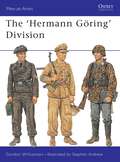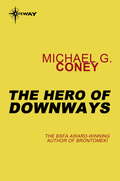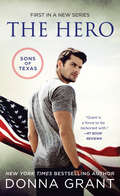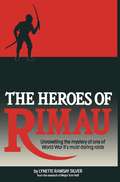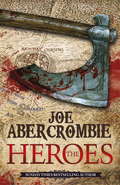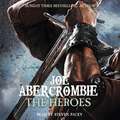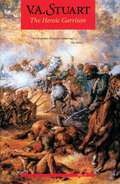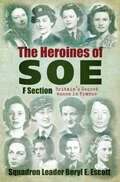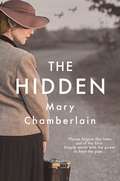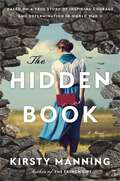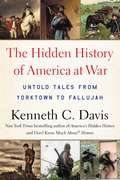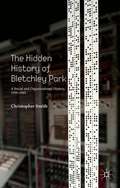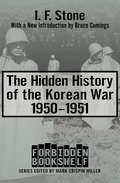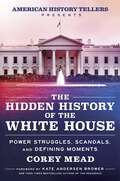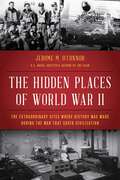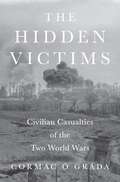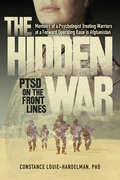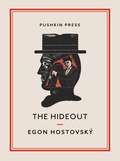- Table View
- List View
The Hermann Göring Division
by Gordon Williamson Stephen AndrewEach of Germany's World War II (1939-1945) armed services could claim one unit which earned a unique combat reputation, and which consequently was enlarged and developed far beyond the size originally planned. Hermann Göring, commander-in-chief of the air force, was determined that his Luftwaffe should share the glory of Germany's land conquests, and gave his name to a regimental combat group of infantry and Flak artillery. This élite unit was steadily enlarged into a brigade, then an armoured division, and finally into a two-division corps, fighting with distinction in Tunisia, Sicily, Italy, and on the Russian Front. This concise history is illustrated with rare personal photographs and eight colour plates, detailing the very varied uniforms and special insignia of this crack formation.
The Hero and the Victim: Narratives of Criminality in Iraq War Fiction
by Gregory BrazealTwo decades after the US invasion of Iraq in 2003, a canon of American literature about the war has begun to emerge. Gregory Brazeal’s The Hero and the Victim situates Iraq War fiction in war literature’s broader history. In contrast to the emphasis of most pre-modern war literature on the figure of the warrior-as-hero, and the growing modern emphasis on the figure of the soldier-as-victim, Iraq War fiction reflects the troubled emergence of a new narrative: the story of the ordinary soldier as a wrongdoer or even criminal. To a greater extent than earlier literature about American wars, Iraq War fiction is haunted by depictions of moral injury and expressions of unresolved guilt. The emphasis on soldier criminality in Iraq War fiction can be partly explained by the rise of moral cosmopolitanism and its blurring of the traditional conceptual lines between war and crime. The anti-war literature of the twentieth century often presented fallen soldiers on both sides equally as victims and viewed the distinction between heroes and villains as part of the illusion that battlefield experience strips away. Written in the long shadow of Nuremberg, Iraq War fiction grapples with the possibility that the soldiers on one’s own side may not be the heroes in the story, or even the victims, but participants in a wrong, and perhaps even complicit in crimes. The Hero and the Victim contributes to the ongoing, public reexamination of American traditions by confronting a topic that has, up to now, been largely untouched: the moral celebration of military service. The Hero and the Victim explores the theme of soldier criminality through close readings of several works by American authors, including Kevin Powers’s The Yellow Birds, Phil Klay’s Redeployment, Helen Benedict’s Sand Queen, Chris Kyle’s American Sniper, and Roy Scranton’s War Porn. This volume will be an essential text for students of American literature, historians of war culture, and any scholar interested in representations of the Iraq War.
The Hero of Downways
by Michael G. ConeyOnce there was a Hero who confronted the dreaded Daggertooth and slew it. Unfortunately he was also slain by it - but the legend persisted. If it could be done once, then another Hero could be raised to do it again. Because the Daggertooth was dangerous to hibernating humanity. All people - all that anyone knew of - lived far underground in tunnels built for safety and hibernation. The Daggertooth was a mass killer - more so even than the hideous Oddlies, the outcasts of the darker tunnels.So this is the story of John-A, the "vatkid" who was trained to be a second Hero. And the story of "trukid" Shirl who taught John-A what to do. And Threesum, the Oddlies' leader, who scoffed at heroes. And the Elders who frowned at all the risky goings-on. This is the story of a mighty strange world and a mighty strange future...
The Hero's Sweetheart (Eagle Point Emergency #4)
by Cheryl WyattThey might not see eye-to-eye, but they meet heart-to-heart in this “inspirational romance with some solidly grounded life lessons” (Fresh Fiction).Military commander Jack Sullenberger is used to saving the day. But when his father has a stroke in his beloved small-town diner, it’s waitress and EMT student Olivia Abbott coming to the rescue. Jack rushes home to tend to his father and take over the business—running right into Olivia’s very strong opinions. The steely military man and the waitress can’t agree on what’s best for the restaurant. When Jack sees something that shakes his growing trust in Olivia, their undeniable connection is put to the test. But if Jack’s open to the truth, they’ll have a chance at finding a future together.“A sweet Christian small-town romance with two characters that appear to be opposites.” —More Than a Review
The Hero: A Western Romance Novel (The Sons of Texas #1)
by Donna GrantThe first book in New York Times bestselling author, Donna Grant’s sexy Sons of Texas series!When his aunt and uncle are murdered, his father goes missing and with his high school sweetheart’s life in danger, Navy SEAL Owen Loughman will stop at nothing to keep her safe.The hero's homecoming.Owen Loughman is a highly-decorated Navy SEAL who has a thirst for action. But there’s one thing he hasn’t been able to forget: his high school sweetheart, Natalie. After more than a decade away, Owen has returned home to the ranch in Texas for a dangerous new mission that puts him face-to-face with Natalie and an outside menace that threatens everything he holds dear. He’ll risk it all to keep Natalie safe—and win her heart.Natalie Dixon has had a lifetime of heartache since Owen was deployed. Fourteen years and one bad marriage later, she finds herself mixed up with the Loughmans again. With her life on the line against an enemy she can’t fight alone, it’s Owen’s strong shoulders, smoldering eyes, and sensuous smile that she turns to. When danger closes in, how much will she risk to stay with the only man she’s ever loved.Publisher’s Weekly (starred review) declared, “This first-class thrill ride will leave readers wanting more.” The Hero is romantic suspense at its sexy, thrilling finest.Don’t miss the other novels in this series:Book #2: The ProtectorBook #3: The Legend
The Heroes of Rimau: Unravelling the Mystery of One of World War II's Most Daring Raids
by Lynette SilverOn September 11, 1944, the British submarine "Porpoise" slipped quietly from Fremantle Harbour, bound for Indonesia. It was carrying the 23 Australian and British members of Operation Rimau who, under the leadership of the remarkable Lieutenant-Colonel Ivan Lyon of the Gordon Highlanders, intended to repeat the successful Jaywick raid of 1943 by blowing up 60 ships in Japanese-occupied Singapore Harbour, 19 days later, the preliminary part of the operation successfully completed, the submarine commander bade farewell to the raiders at Pedjantan Island, promising to return to pick them up in 38 days' time. A handful of Chinese and Malays and the conquering Japanese were the only people ever to see the 23 men again. According to the scant official post-war record, the mission was an utter failure. All of the party were captured of killed - ten of them beheaded in Singapore only five weeks before the Japanese surrender in, it was claimed, a ceremonial execution. The fate of eleven of the others remains officially unknown. After a 31 year search, Major Tom Hall, with the assistance of writer Lynette Silver, has overturned the official version and uncovered the truth. Aided by thousands of Japanese and Allied documents and by the first-hand accounts of several Indonesians and Malays, sole witnesses to the events of 1944, they have established the fate of every member of the party and unravelled the story of "The Heroes of Rimau" - a story that has for 45 years been all but lost, distorted by hearsay and fantasy, by military cover-ups and conspiracy, by official bungling, ineptitude and apathy. This book not only chronicles a feat of extraordinary daring in the face of overwhelming odds - a gripping tale of inspired courage, self-sacrifice and eventual tragedy - it also exposes the appalling sequence of events which has, until now, resulted in the shameful suppression of the truth about one of the most amazing stories to emerge from World War II.
The Heroes: A First Law Novel (World Of The First Law Ser.)
by Joe AbercrombieThey say Black Dow's killed more men than winter, and clawed his way to the throne of the North up a hill of skulls. The King of the Union, ever a jealous neighbour, is not about to stand smiling by while he claws his way any higher. The orders have been given and the armies are toiling through the northern mud.Thousands of men are converging on a forgotten ring of stones, on a worthless hill, in an unimportant valley, and they've brought a lot of sharpened metal with them.Bremer dan Gorst, disgraced master swordsman, has sworn to reclaim his stolen honour on the battlefield. Obsessed with redemption and addicted to violence, he's far past caring how much blood gets spilled in the attempt. Even if it's his own.Prince Calder isn't interested in honour, and still less in getting himself killed. All he wants is power, and he'll tell any lie, use any trick, and betray any friend to get it. Just as long as he doesn't have to fight for it himself.Curnden Craw, the last honest man in the North, has gained nothing from a life of warfare but swollen knees and frayed nerves. He hardly even cares who wins any more, he just wants to do the right thing. But can he even tell what that is with the world burning down around him?Over three bloody days of battle, the fate of the North will be decided. But with both sides riddled by intrigues, follies, feuds and petty jealousies, it is unlikely to be the noblest hearts, or even the strongest arms that prevail.Three men. One battle. No Heroes.
The Heroes: A First Law Novel (World of the First Law)
by Joe AbercrombieThey say Black Dow's killed more men than winter, and clawed his way to the throne of the North up a hill of skulls. The King of the Union, ever a jealous neighbour, is not about to stand smiling by while he claws his way any higher. The orders have been given and the armies are toiling through the northern mud.Thousands of men are converging on a forgotten ring of stones, on a worthless hill, in an unimportant valley, and they've brought a lot of sharpened metal with them.Bremer dan Gorst, disgraced master swordsman, has sworn to reclaim his stolen honour on the battlefield. Obsessed with redemption and addicted to violence, he's far past caring how much blood gets spilled in the attempt. Even if it's his own.Prince Calder isn't interested in honour, and still less in getting himself killed. All he wants is power, and he'll tell any lie, use any trick, and betray any friend to get it. Just as long as he doesn't have to fight for it himself.Curnden Craw, the last honest man in the North, has gained nothing from a life of warfare but swollen knees and frayed nerves. He hardly even cares who wins any more, he just wants to do the right thing. But can he even tell what that is with the world burning down around him?Over three bloody days of battle, the fate of the North will be decided. But with both sides riddled by intrigues, follies, feuds and petty jealousies, it is unlikely to be the noblest hearts, or even the strongest arms that prevail.Three men. One battle. No Heroes.
The Heroes: A First Law Novel (World of the First Law)
by Joe AbercrombieThey say Black Dow's killed more men than winter, and clawed his way to the throne of the North up a hill of skulls. The King of the Union, ever a jealous neighbour, is not about to stand smiling by while he claws his way any higher. The orders have been given and the armies are toiling through the northern mud. Thousands of men are converging on a forgotten ring of stones, on a worthless hill, in an unimportant valley, and they've brought a lot of sharpened metal with them. Bremer dan Gorst, disgraced master swordsman, has sworn to reclaim his stolen honour on the battlefield. Obsessed with redemption and addicted to violence, he's far past caring how much blood gets spilled in the attempt. Even if it's his own.Prince Calder isn't interested in honour, and still less in getting himself killed. All he wants is power, and he'll tell any lie, use any trick, and betray any friend to get it. Just as long as he doesn't have to fight for it himself.Curnden Craw, the last honest man in the North, has gained nothing from a life of warfare but swollen knees and frayed nerves. He hardly even cares who wins any more, he just wants to do the right thing. But can he even tell what that is with the world burning down around him?Over three bloody days of battle, the fate of the North will be decided. But with both sides riddled by intrigues, follies, feuds and petty jealousies, it is unlikely to be the noblest hearts, or even the strongest arms that prevail.Three men. One battle. No Heroes.
The Heroic Garrison
by V. A. StuartIn this final volume of Stuart's Sheridan series, General Havelock's Moveable Column—a force of barely a thousand men—has finally fought its way through to the heroic garrison defending the Residency in Lucknow, only to be besieged themselves by the 60,000 mutinous sepoys in the city. They must hold firm until the relieving force reaches them. Meanwhile, Colonel Alex Sheridan volunteers for a dangerous mission, but is captured. He is soon called upon to fight a much more personal war: assassination of the very man who ordered the deaths of his wife and child!
The Heroines of SOE: Britain's Secret Women in France: F Section
by Beryl E EscottBritain’s war in the shadows of male spies and subterfuge in the heart of occupied France is a story well known, but what of the women who also risked their lives for Britain and the liberation of France? In 1942 a desperate need for new recruits, saw SOE turn to a previously overlooked group – women. These extraordinary women came from different backgrounds, but were joined in their idealistic love of France and a desire to play a part in its liberation. They formed SOE’s F Section. From the famous White Mouse, Nancy Wake, to the courageous, Noor Inayat Khan, they all risked their lives for King, Country and the Resistance. Many of them died bravely and painfully, and often those who survived, like Eileen Nearne, never told their stories, yet their secret missions of intelligence-gathering and sabotage undoubtedly helped the Resistance to drive out their occupiers and free France. Here, for the first time is the extraordinary account of all forty SOE F women agents. It is a story that deserves to be read by everyone. ‘They were the war’s bravest women, devoted to defeating the Nazis yet reluctant ever to reveal their heroic pasts. Now a new book tells their intrepid tales.’ Daily Express Squadron Leader BERYL E. ESCOTT served in the RAF and is one of the foremost experts on the women of SOE.
The Hidden
by Mary ChamberlainHer heart died in the war – can she breathe new life into it? Dora Simon and Joe O’Cleary live in separate countries, accepting of their twilight years. But their monochrome worlds are abruptly upended by the arrival of Barbara Hummel, who is determined to identify the mysterious woman whose photograph she has found among her mother’s possessions.Forced to confront a time they thought buried in the past, Dora and Joe’s lives unravel – and entwine. For, trapped on the Channel Islands under the German occupation in the Second World War, Dora, a Jewish refugee, had concealed her identity; while Joe, a Catholic priest, kept quite another secret...This is a story of love and betrayal, shame and survival. But can a speck of light diffuse the darkest shadows of war?
The Hidden Book: A Novel
by Kirsty ManningFrom bestselling author Kirsty Manning comes a stunning novel based on a true story of clandestine courage in World War II as prisoners of war risk their lives to secure evidence of Nazi atrocities—and how one man concealed it for decades before passing it on to his family who struggle to understand their inherited legacy of trauma. Austria, 1940s: Yugoslavian Nico Antonov is just one of more than 200,000 people imprisoned in the Mauthausen concentration camp near the Danube River. Malnourished and forced into hard labor in a quarry, he still defies his captors any way he can. When fate brings him into contact with Lena Lang, a young woman living with her family in fear of their Nazi occupiers, he finds an ally.SS officers have charged Spanish POW and photographer Mateo Baca with recording the events and prisoners of Mauthausen and to make five copies of the collected photo book for the Third Reich’s leaders. But Mateo also creates a sixth book to be smuggled out of the camp—where Nico entrusts Lena to hide it and protect their secret.Australia, 1980s to present day: When teenager Hannah Campbell discovers her grandfather Nico’s mysterious photo album, filled with horrific visions of suffering and cruelty, the barbarities of World War II no longer feel like ancient history. Haunted by the images for years, as a university student and a married young mother, she pursues the truth behind her grandfather’s incarceration. As Hannah experiences love and loss in her own life, she comes to understand how the photos not only capture history but reflect a shared humanity that must never be forgotten.
The Hidden Hindenburg: The Untold Story of the Tragedy, the Nazi Secrets, and the Quest to Rule the Skies
by Michael McCarthyBy the author of Ashes Under Water (Lyons Press), here is one of the great untold stories of World War II. The Hidden Hindenburg at last reveals the cause of aviation&’s most famous disaster and the duplicity that kept the truth from coming to light for three generations. Italso finally catches up with a German legend who misled the world about the Hindenburg to bury his own Nazi connections. Drawing on previously unpublished documents from the National Archives in Washington, along with archival collections in Germany, this definitive account explores how the Hindenburg was connected to the Dachau concentration camp, a futuristic German rocket that terrified the Allies, and a classified project that imported Nazi scientists to America after the war. It took author Michael McCarthy four years to get to the bottom of this epic disaster, in which the largest object civilization has ever managed to fly burnt up in less than one minute. Along the way, he found a tale of international intrigue, revealing a whistleblower, a cover-up and corruption on two continents.
The Hidden History of America at War: Untold Tales from Yorktown to Fallujah
by Kenneth C. DavisMulti-million-copy bestselling historian Kenneth C. Davis sets his sights on war stories in The Hidden History of America at War. In prose that will remind you of "the best teacher you ever had" (People Magazine), Davis brings to life six emblematic battles, revealing untold tales that span our nation's history, from the Revolutionary War to Iraq. Along the way, he illuminates why we go to war, who fights, the grunt's-eye view of combat, and how these conflicts reshaped our military and national identity.From the Battle of Yorktown (1781), where a fledgling America learned hard lessons about what kind of military it would need to survive, to Fallujah (2004), which epitomized the dawn of the privatization of war, The Hidden History of America at War takes readers inside the battlefield, introducing them to key characters and events that will shatter myths, misconceptions, and romanticism, replacing them with rich insight.
The Hidden History of Bletchley Park: A Social And Organisational History, 1939-1945
by Christopher SmithThis book is a 'hidden' history of Bletchley Park during the Second World War, which explores the agency from a social and gendered perspective. It examines themes such as: the experience of wartime staff members; the town in which the agency was situated; and the cultural influences on the wartime evolution of the agency.
The Hidden History of the Korean War, 1950–1951: 1950-1951 (Forbidden Bookshelf #10)
by I. F. Stone&“A great journalist&” raises troubling questions about the forgotten war in this courageous, controversial book—with a new introduction by Bruce Cumings (The Baltimore Sun). &“Much about the Korean War is still hidden, and much will long remain hidden. I believe I have succeeded in throwing new light on its origins.&” —From the author&’s preface In 1945 US troops arrived in Korea for what would become America&’s longest-lasting conflict. While history books claim without equivocation that the war lasted from 1950 to 1953, those who have actually served there know better. By closely analyzing US intelligence before June 25, 1950 (the war&’s official start), and the actions of key players like John Foster Dulles, General Douglas MacArthur, and Chiang Kai-shek, the great investigative reporter I. F. Stone demolishes the official story of America&’s &“forgotten war&” by shedding new light on the tangled sequence of events that led to it. The Hidden History of the Korean War was first published in 1952—during the Korean War—and then republished during the Vietnam War. In the 1990s, documents from the former Soviet archives became available, further illuminating this controversial period in history.
The Hidden History of the White House: Power Struggles, Scandals, and Defining Moments
by Corey MeadPresented by the hit podcast American History Tellers, The Hidden History of the White House reveals the behind-the-scenes stories of some of the most dramatic events in American history—set right inside the house where it happenedFor more than two centuries, the White House in Washington, DC, has been the stage for some of the most climactic moments in American history. Its walls and portraits have witnessed fierce power struggles, history-altering decisions, shocking scandals, and intimate moments among the First Family, their guests, and the staff.In the signature style of the popular American History Tellers podcast, The Hidden History of the White House places readers in the shoes of historical figures—from power brokers to everyday Americans alike—who lived through pivotal events that shaped America.As a fly on the wall of history, you’ll find yourself immersed in:Andrew Jackson’s disastrous 1829 inauguration, when a mob overran and trashed the White House.Woodrow Wilson’s stroke, which led to his wife Edith serving as shadow president during the final months of his administration.President-elect Abraham Lincoln’s clandestine journey to Washington to dodge an assassination plot on the eve of the Civil War.Winston Churchill’s wartime sojourn at the White House, during which he and FDR developed plans to defeat Germany.Barack Obama’s decision to green-light the Navy SEAL raid that killed Osama bin Laden.Equal parts social, political, and cultural history—written and presented in the accessible and engaging style for which American History Tellers is famous—The Hidden History of the White House offers readers a rare opportunity to live within the halls of the Executive Mansion, and explore some of the extraordinary people and events that made America what it is today.
The Hidden Nazi: The Untold Story of America's Deal with the Devil
by Dean Reuter Keith Chester Colm LoweryHe’s the worst Nazi war criminal you’ve never heard of Sidekick to SS Chief Heinrich Himmler and supervisor of Nazi rocket scientist Wernher von Braun, General Hans Kammler was responsible for the construction of Hitler’s slave labor sites and concentration camps. He personally altered the design of Auschwitz to increase crowding, ensuring that epidemic diseases would complement the work of the gas chambers. Why has the world forgotten this monster? Kammler was declared dead after the war. But the aide who testified to Kammler’s supposed “suicide” never produced the general’s dog tags or any other proof of death. Dean Reuter, Colm Lowery, and Keith Chester have spent decades on the trail of the elusive Kammler, uncovering documents unseen since the 1940s and visiting the purported site of Kammler’s death, now in the Czech Republic. Their astonishing discovery: US government documents prove that Hans Kammler was in American custody for months after the war—well after his officially declared suicide. And what happened to him after that? Kammler was kept out of public view, never indicted or tried, but to what end? Did he cooperate with Nuremberg prosecutors investigating Nazi war crimes? Was he protected so the United States could benefit from his intimate knowledge of the Nazi rocket program and Germany’s secret weapons? The Hidden Nazi is true history more harrowing—and shocking—than the most thrilling fiction.
The Hidden Places of World War II: The Extraordinary Sites Where History Was Made During the War That Saved Civilization
by Jerome M. O'ConnorIn The Hidden Places of WWII, the author takes readers to overlooked places where WWII history was made. These are sites that were thought to be closed or locked away forever or, in some cases, thought never to exist at all, or were ignored by military historians for decades. With historical photos, contemporary photos, and written in a conversational style, the book opens the eyes of a new generation of readers, as well as an older generation, and takes them to the actual locations that changed history. Many military history readers don&’t know that you can still visit Nazi U-boat pens in Lorient and La Rochelle on the French Atlantic coast (they were used in the filming of Raiders of the Lost Ark) and even pieces of the Atlantic Wall Hitler had built along the French coast in &’43 and &’44 to thwart the invasion he knew was coming. These are only two of the many hidden places the author introduces the reader to.
The Hidden Threat: Mines and Minesweeping Reserve in WWI
by Jim CrossleyIt is not widely remembered that mines were by far the most effective weapon deployed against the British Royal Navy in WW1, costing them 5 battleships, 3 cruisers, 22 destroyers, 4 submarines and a host of other vessels. They were in the main combated by a civilian force using fishing boats and paddle steamers recruited from holiday resorts. This unlikely armada saved the day for Britain and her allies. After 1916, submarine attacks on merchant ships became an even more serious threat to Allied communications but submarines were far less damaging to British warships than mines.This book contains the following:Mines in WWIMain cause of ship losses; The Konigin Louise; Loss of Amphion; The Berlin; Loss of Audacity; Losses in the Dardanelles; The Meteor; German mines and how they worked; Minefields - British and German; Fast minelayers; Submarine minelayers.Formation of RNMRPersonnel and discipline; Sweeping technique and gear; Trawlers and drifters; Paddlers; Fleet minesweepers; Sloops.ActionsEast Coast and the Scarborough Raid; Dardanelles; Dover Straight; Mine ClearanceSome Typical IncidentsMine strikes and Mine sweeping.StatisticsMines swept; Ships lost; Minesweepers lost.
The Hidden Victims: Civilian Casualties of the Two World Wars (The Princeton Economic History of the Western World)
by Cormac Ó GrádaA staggering new account of the civilian death toll of the world wars—and what it reveals about the true nature and cost of modern warSoldiers have never been the only casualties of wars. But the armies that fought World Wars I and II killed far more civilians than soldiers as they countenanced or deliberately inflicted civilian deaths on a mass scale. By one reputable estimate, 9.7 million civilians and 9 million combatants died in World War I, while World War II killed 25.5 million civilians and 15 million combatants. But in The Hidden Victims, Cormac Ó Gráda argues that even these shocking numbers are almost certainly too low. Carefully evaluating all the evidence available, he estimates that the wars cost not 35 million but some 65 million civilian lives—nearly two-thirds of the 100 million total killed. Indeed, he shows that war-induced famines alone may have killed 30 million people, making them the single largest cause of death.The Hidden Victims is the first book to attempt to measure and describe the full scale of civilian deaths during the world wars, from all causes, including genocide, starvation, aerial bombardment, and disease. While nations went to great lengths to record military casualties, they often didn&’t count or deliberately obscured civilian deaths. Getting the numbers right is important. It reveals much about the true human costs of the wars, the nature of modern warfare, and the failure of efforts to stop civilian casualties. It also makes it possible to argue with those who try to deny, minimize, or exaggerate wartime savagery.
The Hidden War: PTSD on the Front Lines
by Constance Louie-HandelmanDriven by her passionate desire to serve, psychologist Connie Louie-Handelman joined the US Army at the age of 56. Disturbed by the high rates of PTSD and suicide among warriors, she wanted to make a difference. After training, she was deployed at a forward operating base in the hot and dusty plains of Kandahar, Afghanistan. There she found soldiers fighting more than the enemies they encountered in the battlefield. The casualty rate from invisible enemies like anxiety, depression, low self-esteem, and fear was high. When improvised explosive devices killed or wounded warriors near the base, she would journey "outside the wire" to units that were under attack. Besides their shattering experiences on the battlefield, many warriors were also locked in domestic tragedies, with spouses having affairs or wanting divorces, or children going astray. Connie and her fellow mental health professionals faced enormous obstacles as they treated their patients. Basic supplies were scarce and they worked out of tiny spaces where privacy was impossible. Many warriors were rotating through different duty stations and Connie often had only one session to help them before they moved on. Besides her conventional psychological training, Connie had a "secret weapon" for treating trauma. Emotional Freedom Techniques (EFT) combines elements of cognitive therapy with acupressure, in the form of fingertip tapping on acupuncture points. She describes how she used EFT to treat PTSD, anger, insomnia, depression, and stress. Many of her patients calmed down within a few minutes of tapping and were able to make substantial progress, often in just a single session. They learned EFT quickly and many referred their buddies. In this lucid and compelling account, she shares the knowledge she gained while treating 199 warriors over a total of 574 sessions. She went on to become a passionate advocate for EFT as well as work for the Veterans Administration.
The Hideout
by Egon Hostovský Fern LongA kind, blundering Czech engineer is pressured by the Nazi government to hand over his invention, which could be key to their military operations. He flees to Paris, hoping to sell his invention to the French government instead; yet when the Germans invade France, he is forced into hiding, and spends months in a dark, damp cellar. Alone, he dwells on his memories - of his troubled marriage, and his decision to leave his wife behind in Czechoslovakia. When he is given the unexpected chance to redeem himself, both to his wife and history, he seizes it with utter determination - even though this heroic act will be his last.A powerful and moving novel about one man's final, fatal, heroic act of resistance in Nazi France.
The Hiding Place
by John Sherrill Elizabeth Sherrill Corrie Ten BoomCorrie ten Boom was a woman admired the world over for her courage, her forgiveness, and her memorable faith. In World War II, she and her family risked their lives to help Jews escape the Nazis, and their reward was a trip to Hitler's concentration camps. But she survived and was released--as a result of a clerical error--and now shares the story of how faith triumphs over evil. For thirty-five years Corrie's dramatic life story, full of timeless virtues, has prepared readers to face their own futures with faith, relying on God's love to overcome, heal, and restore. Now releasing in a thirty-fifth anniversary edition for a new generation of readers, The Hiding Place tells the riveting story of how a middle-aged Dutch watchmaker became a heroine of the Resistance, a survivor of Hitler's death camps, and one of the most remarkable evangelists of the twentieth century.
